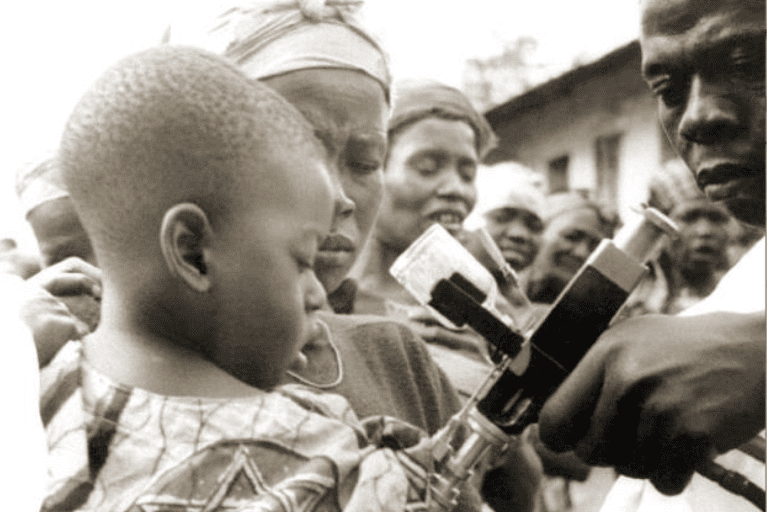
The National Foundation for Infectious Diseases (NFID) is celebrating its 50th anniversary in 2023 with a look back at remarkable accomplishments and significant moments in public health history. Few achievements can compare to the global eradication of smallpox.
 Smallpox is the first and only infectious disease that has been eradicated in humans, which means it no longer exists naturally anywhere in the world. Smallpox is also the first disease for which a vaccine was developed and vaccination played a significant role in eradicating the disease.
Smallpox is the first and only infectious disease that has been eradicated in humans, which means it no longer exists naturally anywhere in the world. Smallpox is also the first disease for which a vaccine was developed and vaccination played a significant role in eradicating the disease.
Prior to eradication, smallpox was a serious disease caused by the variola virus. It frequently led to permanent scarring, blindness, and in many cases death. Smallpox spread from person to person through direct and prolonged contact. When an infected person coughed or sneezed, droplets from their nose and mouth containing viral particles were transmitted to others. Smallpox also spread if contaminated items, or the scabs and fluid from a patient, came into contact with susceptible individuals.
Before smallpox was eradicated, the disease took a significant toll on humanity:
- About 3 out of every 10 people infected with smallpox died
- About 500 million people died due to smallpox over 3,000 years, including 300 million deaths in the 20th century alone
- According to World Health Organization (WHO) estimates, 65-80% of smallpox survivors suffered from deep scars (pockmarks)
- About 5-9% of smallpox survivors developed ocular complications such as blindness
Smallpox History
Early efforts to prevent smallpox occurred through variolation, a process where material from smallpox pustules was scratched into the skin or inhaled by a person who had never been infected before. Variolated individuals were much less likely to die from smallpox than those who acquired it naturally. However, this method of using a “controlled” inoculation with the actual smallpox virus sometimes had unfortunate results. Individuals could become very ill if the virus spread beyond the inoculation site to other parts of the body. Also, the virus could spread to others, thereby initiating local outbreaks of smallpox. Thus, variolation had serious limitations.
In 1796, English physician Edward Jenner observed that milkmaids who previously had cowpox (which is caused by a virus that is closely related to variola) were resistant to smallpox. By transferring material from a cowpox sore on a milkmaid named Sarah Nelmes into the arm of James Phipps, the son of his gardener, Jenner observed that Phipps had developed immunity to smallpox after exposure to the variola virus. This major discovery led to the development of the first vaccine against smallpox derived from cowpox.
 WHO began planning efforts to eradicate smallpox in 1959, but the campaign fell short due to a lack of resources, funding, and global commitment. In 1967, efforts were revived through the Intensified Eradication Program. Vaccine research developments, advances in surveillance, and mass vaccination programs across the globe contributed to the success of the program.
WHO began planning efforts to eradicate smallpox in 1959, but the campaign fell short due to a lack of resources, funding, and global commitment. In 1967, efforts were revived through the Intensified Eradication Program. Vaccine research developments, advances in surveillance, and mass vaccination programs across the globe contributed to the success of the program.
Surveillance and containment strategies were critical to eradication. Intensive surveillance allowed public health workers to identify smallpox cases early, isolate and interview smallpox patients, identify people who had been exposed as well as their close contacts, notify them of their exposure, and monitor their health. These contacts and those near them were vaccinated in what is known as ring vaccination, a process used to prioritize resources and prevent further spread of the disease by forming a protective “ring” of immunity around infected individuals.
International collaboration on the strategic use of smallpox vaccine resulted in the global eradication of this feared infectious disease. The last naturally occurring case of smallpox occurred in Somalia in 1977. The last fatal case of smallpox occurred in England in 1978. Smallpox was declared officially eradicated by the World Health Assembly in 1980, and there have been no naturally occurring cases since then.
Because smallpox has been eradicated, smallpox vaccines are no longer used in the general public. However, if a smallpox outbreak were to occur, there are licensed vaccines available in the US that are safe to use against smallpox. Smallpox vaccination can protect recipients from getting sick or reduce the severity of illness if received prior to, or within a week of, exposure. Immunity typically lasts 3-5 years and wanes over time, indicating boosters may be required. The current smallpox vaccines may cause mild side effects but have been effective in preventing infections among 95% of those infected.
Smallpox eradication is hailed as one of the greatest public health achievements of all time.
Smallpox eradication changed my life. I had planned to spend 2 years at the Centers for Disease Control and Prevention (CDC) as an Epidemic Intelligence Service officer and then continue my training to be a pediatric nephrologist. I volunteered to go to India to work on smallpox and saw this terrible disease disappear before my eyes with a vaccine. I quickly became hooked on vaccinology.
NFID Past President Walter A. Orenstein, MD
Public Health Heroes Reflect on Smallpox
Listen to these episodes of the Infectious IDeas podcast in which former Centers for Disease Control and Prevention (CDC) Director William H. Foege, MD, MPH, and NFID Past President Walter A. Orenstein, MD, reflect on their first-hand experiences with smallpox eradication …
Episode 7
Episode 8
To join the conversation and get the latest news on infectious diseases, follow NFID on Twitter, like us on Facebook, follow us on Instagram, visit us on LinkedIn, listen and subscribe to the Infectious IDeas podcast, and subscribe to receive future NFID Updates.
Related Posts

Flawed ACIP Process Leads to Confusion and Distrust
Public health experts and leading healthcare professionals share concerns regarding the June 2025 Advisory Committee on Immunization Practices (ACIP) meeting on US immunization policy …

Empowering Men to Prioritize Health
Staying up to date on all recommended vaccines and taking other steps to prevent illness helps ensure men are ready for what matters most—showing up for loved ones or simply enjoying life …

Autism and Vaccines: What the Science Really Says
Progress is being made in the search for the causes of autism, and this information may be valuable for families who are hesitant about vaccines
